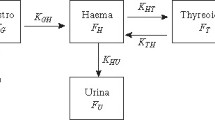Abstract
Proposed was a procedure for constructing mathematical models of the kinetics of tagged compounds in human organism for estimation of the structural and functional conditions of the vitally important organs. Efficiency and adequacy of the models was illustrated by particular examples of estimating the radionuclide examination of lungs, liver, and kidneys.
Similar content being viewed by others
REFERENCES
Novosel’tsev, V.N. and Yashin, A.I., Horizons of Mathematical Modeling, Tr. Mezhdunar. konf. “’Parallel’nye vychisleniya i zadachi upravleniya RASO-2201” (Proc. Int. Conf. “Parallel Calculations and Control Problems RASO-2201”), 2001, pp. 214–244.
Podval’nyi, E.S., Modeling, Individual Forecasting, and Classification of Conditions in the Systems of Monitoring Chronic Invalids, Doctoral Dissertation, Voronezh, 1999.
Coker, A.L., Watkins, K.W., Smith, P.H., and Brandt, H.M., Social Support Reduces the Impact of Partner Violence on Health: Application of Structural Equation Models, Prev. Med., 2003, vol. 37, no. 3, pp. 259–267.
Babushkina, N.A., Matematicheskoe modelirovanie kak metod izucheniya funktsionirovaniya organizma (Mathematical Modeling as a Tool for Studying Functioning of Organism), Moscow: Mosk. Inst. Radiotekhn. Elektron. Avtom., 1995.
Sinyakova, O.G., Proskurina, G.B., and Sharifullin, F.A., Mathematical Modeling in the Design of the Automatic Radiologist Workplace, Sb. nauchn. tr. Nauchnoi sessii MIFI-99 (Collected Papers of Scientific Session MIFI-99), Moscow, 1999, vol. 7, pp. 224–225.
Narkevich, B. Ya., Mathematical Modeling in Radionuclide Diagnostics of the Condition of Physiological Systems, Med. Radiol., 1981, no. 5, pp. 70–76.
Vidyukov, V.I., Man-Computer Analysis of the Scintigraphic Data, Vestn. Radiologii Rentgenologii, 1996, no. 4, pp. 180, 181.
Ermolov, A.S., Sinyakova, O.G., and Ishmukhametov, A.I., Komp’yuternye tekhnologii v analize klinikofiziologicheskikh issledovanii v neotlozhnoi khirurgii (Computer-assisted Technologies in Analysis of the Clinical and Physiological Studies in Acute Surgery), Moscow: “Triada-farm”, 2002.
Teertsira, H.J. and Jamssen, P.J., The Use of Computer in Ventilation-Perfusion Scintigraphy with Tc-99m Macroaggregates and Kr-81m, to Obtain a Physiological Model, Eur. J. Nucl. Med., 1987, vol. 13, pp. 24–27.
Brix, G., Ziegler, S.I., Bellemann, M.E., Doll, J., et al., Quantification of FDG Uptake in the Normal Liver Using Dynamic PET: Impact and Modeling of the Dual Hepatic Blood Supply, J. Nucl. Med., 2001, vol. 42, no. 8, pp. 1265–1273.
Wallin, L. and Helin, I., Kidney Swelling Findings on DMSA Scintigraphy, Clin. Nucl. Med., 1997, vol. 22, no. 5, pp. 292–299.
Glantz, S.A., Primer of Biostatistics, New York: McGrow Hill, 1994. Translated under the title Medikobiologicheskayastatistika, Moscow: Praktika, 1999.
Siniakova, O.G. and Ishmuchametov A.I., Medical Diagnostic System Based on Image Receivers of Various Spectral Ranges, Proc. SPIE—Int. Soc. Optical Engineering, USA, 1996, vol. 2790, no. 6, pp. 118–123.
Howarth, D.M., Lan, L., Thomas, P.A., and Allen, L.W., 99mTc Technegas Ventilation and Perfusion Lung Scintigraphy for the Diagnosis of Pulmonary Embolus, J. Nucl. Med., 1999, vol. 40, no. 4, pp. 579–584.
Banci, M. and Ierarc, M., Reliability of Visual and Quantitative Hepatobiliary Scintigraphy in the Followup of Patients who Have Undergone Cholecystectomy and Transduodenal Sphincteroplasty, Clin. Nucl. Med., 1999, vol. 24, no. 5, pp. 330–333.
Obukhova, T.V. and Nikitinskaya, L.P., Informativeness and Reliabilityof the Radioisotope Methods of Diagnosis at Determining the Functional Condition of Kidneys, Tez. dokl. Shkola “Yadernaya meditsinav XXI veke, klinicheskie i metodicheskie aspekty ispol’zovaniya radiofarmatsevticheskikh preparatov na osnove Tc-99m” (Abstracts. School “Nuclear Medicine in the XXIst Century, Clinical and Procedural Aspects of Using the Tc-99m-based Radiotracers”), Dubna, 2002, pp. 29–31.
Author information
Authors and Affiliations
Additional information
Translated from Avtomatika i Telemekhanika, No. 1, 2005, pp. 142–153.
Original Russian Text Copyright © 2005 by Sinyakova.
Rights and permissions
About this article
Cite this article
Sinyakova, O.G. Methods of mathematical modeling for estimation of the organism condition (radionuclide diagnostics). Autom Remote Control 66, 129–138 (2005). https://doi.org/10.1007/s10513-005-0013-5
Received:
Issue Date:
DOI: https://doi.org/10.1007/s10513-005-0013-5




